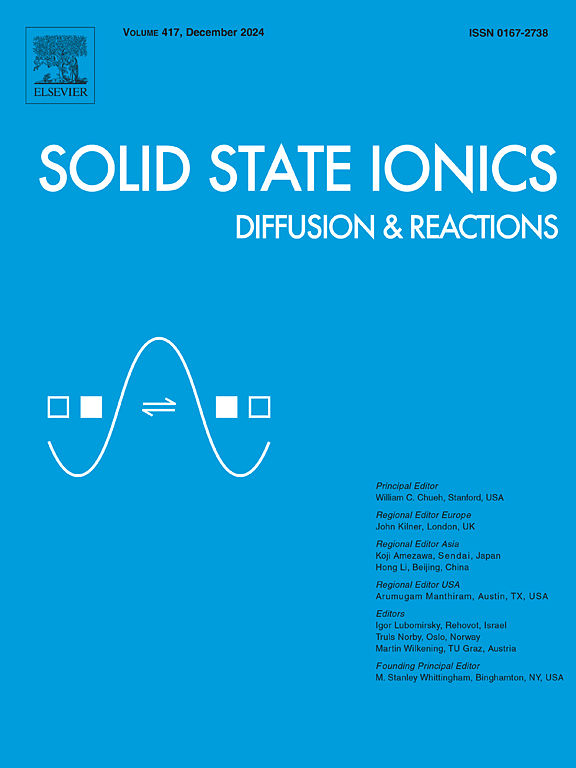由Mg2+, Y3+共掺杂氧化锆前驱体制备无氧化锆细晶nasicon型固体电解质
IF 3.3
4区 材料科学
Q3 CHEMISTRY, PHYSICAL
引用次数: 0
摘要
随着人们对高能量密度、高安全性全固态电池需求的不断增长,高性能固态电解质的开发成为人们关注的焦点。nasiconon结构的Na3Zr2Si2PO12由于其优异的热稳定性和化学稳定性被认为是一种有前途的固态电解质材料。然而,其实际应用受到单斜ZrO2 (m-ZrO2)杂质相的存在和室温下离子电导率低的限制。本研究采用固态法合成了不含m-ZrO2杂质相的细晶(0.5-0.7 μm) nasiconon型材料,并用Mg2+和Y3+共掺杂氧化锆前驱体代替传统氧化锆。消除m-ZrO2杂质相,实施Mg2+和Y3+共掺杂策略,同时优化了体界和晶界结构,降低了电阻,扩大了Na+离子输运通道的瓶颈尺寸。交流阻抗谱分析表明,掺8mol % MgO的Na3.32Mg0.12Y0.08Zr1.84Si2PO12的室温电导率由0.43 mS cm - 1提高到1.10 mS cm - 1,用2mol % Y2O3取代MgO后,Na3.32Mg0.12Y0.08Zr1.84Si2PO12的室温电导率提高到2.32 mS cm - 1。本研究提出了一种通过多因素调控来提高nasicon结构固态电解质离子电导率的可行方法。本文章由计算机程序翻译,如有差异,请以英文原文为准。
Zirconia-free fine-grained NASICON-type solid electrolyte prepared from Mg2+, Y3+ co-doping zirconia precursors
The increasing demand for all-solid-state batteries with high energy density and enhanced safety has attracted attention to the development of high-performance solid-state electrolytes. NASICON-structured Na3Zr2Si2PO12 is considered as a promising solid-state electrolyte material due to its superior thermal and chemical stability. However, its practical application is constrained by the presence of monoclinic ZrO2 (m-ZrO2) impurity phase and low ionic conductivity at room temperature. This study presents the synthesis of fine-grained (0.5–0.7 μm) NASICON-type materials free from m-ZrO2 impurity phase via a solid-state method, and using Mg2+ and Y3+ co-doped zirconia precursor as a substitute for conventional zirconia. The elimination of the m-ZrO2 impurity phase and the implementation of Mg2+ and Y3+ co-doping strategy simultaneously optimized the bulk and grain boundary structure, reduced resistance, and enlarged the bottleneck size of Na+ ion transport channels. AC impedance spectroscopy analysis revealed that the room temperature conductivity of Na3.32Mg0.16Zr1.84Si2PO12 doped with 8 mol% MgO increased from 0.43 mS cm−1 to 1.10 mS cm−1, and further increased to 2.32 mS cm−1 upon substitution of MgO with 2 mol% Y2O3 in Na3.32Mg0.12Y0.08Zr1.84Si2PO12. This study presents a feasible approach to enhance the ionic conductivity of NASICON-structured solid-state electrolytes through the regulation of multiple factors.
求助全文
通过发布文献求助,成功后即可免费获取论文全文。
去求助
来源期刊

Solid State Ionics
物理-物理:凝聚态物理
CiteScore
6.10
自引率
3.10%
发文量
152
审稿时长
58 days
期刊介绍:
This interdisciplinary journal is devoted to the physics, chemistry and materials science of diffusion, mass transport, and reactivity of solids. The major part of each issue is devoted to articles on:
(i) physics and chemistry of defects in solids;
(ii) reactions in and on solids, e.g. intercalation, corrosion, oxidation, sintering;
(iii) ion transport measurements, mechanisms and theory;
(iv) solid state electrochemistry;
(v) ionically-electronically mixed conducting solids.
Related technological applications are also included, provided their characteristics are interpreted in terms of the basic solid state properties.
Review papers and relevant symposium proceedings are welcome.
 求助内容:
求助内容: 应助结果提醒方式:
应助结果提醒方式:


